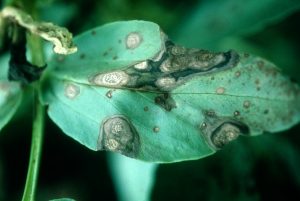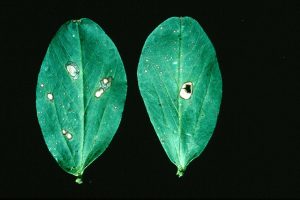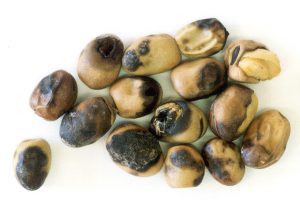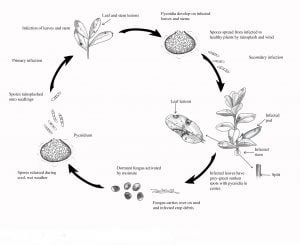Ascochyta blight, caused by Ascochyta fabae, is an important disease of faba beans in Victoria, South Australia and New South Wales. The disease is widespread in southern Australia, but its severity varies considerably from crop to crop and between seasons. Yield losses of 10 – 30 per cent can occur in seasons favourable for the disease.
A shift in virulence for ascochyta blight found in the mid-north of SA has resulted in the disease ratings for ascochyta blight separated into pathotype 1 (widely distributed in the southern region) and pathotype 2 (recently identified in the mid-north of South Australia and Kaniva region of Victoria).
What to Look For
Lesions can form on leaves, stems and pods of infected plants and may be confused with the early stages of chocolate spot. On both the top and bottom sides of leaves; small, circular, dark brown spots first appear which enlarge and turn light to dark grey in colour as the disease develops. They become irregular in shape, often zonate and may coalesce to cover most of the leaf surface. Leaf tissue next to the lesions may become black and necrotic. Within the lesions, numerous pinhead-sized black fruiting bodies (pycnidia) of the fungus develop.
Pycnidia are only formed under moist conditions and are often concentrically arranged. On the stem, lesions are more elongated, sunken and darker than leaf lesions and are usually covered with scattered pycnidia.
Stems may split and break at the point of infection causing plants to lodge.
On pods, lesions are sunken, with pale centres and dark margins and may be covered by numerous pycnidia. Well-developed lesions may penetrate the pod and infect developing seeds causing them to be shrunken and discoloured. Badly infected seeds have yellowish-brown stains on the outer seed coat.
Disease Cycle
The fungus can survive on crop debris, self-sown volunteer plants and infected seed. The disease often becomes established when fungal spores, produced on old bean trash are carried by wind into new crops and infect young seedlings.
During wet weather the fungus spreads from infected to healthy plants by rain-splash and wind-borne water droplets. Providing there has been either rain or heavy dew, infection may occur at any stage of plant growth and because of this dependence on wet conditions, the disease is most severe early in the season and in wet years.
Management
An integrated approach is the key to successful management of ascochyta blight in faba bean.
Paddock Selection
A break of at least 3 years should be observed between faba bean crops. Aim to separate this year’s faba bean crop from last year’s faba bean stubble by a distance of 500m. Reduce disease risk by not sowing adjacent to vetch, chickpea or lentil stubble.
Variety Selection
Select the variety with the highest level of resistance to the important disease risk in your district. Nura and PBA Samira are the only varieties resistant to both ascochyta pathotypes. Farah, PBA Rana and PBA Zahra are only resistant to the most prevalent form of ascochyta blight (pathotype 1). Consult the latest pulse disease guide for up to date ratings.
Sowing Rate
Follow the recommended sowing rates for your district, remember that rates may vary between varieties. Plan to sow within the optimum sowing window for your district.
Strategic Use of Foliar Fungicides
A successful fungicide program relies on crop monitoring, correct disease identification and timeliness of spraying with the correct product. Be aware of the critical periods for disease management.
Harvest
Plan to harvest as early as possible to minimize disease infection on seed.
Seed Selection
Aim to use the ‘cleanest’ seed possible with 5 per cent to nil levels of ascochyta present. Seed should be sourced from the ‘cleanest’ crops. Old, frosted or damaged seed may have reduced germination and reduced vigour.






